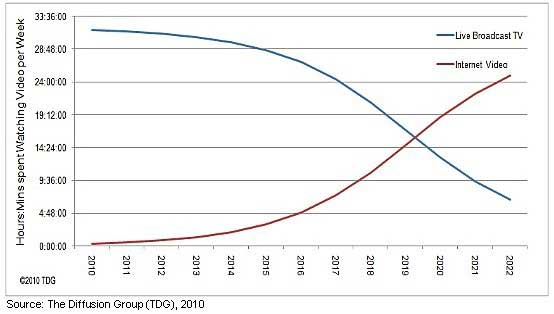The consumption of Internet video—content stored and distributed over Internet protocol (IP) architecture—is forecast to overtake the consumption of broadcast TV programming by 2020, according to a report by The Diffusion Group (TDG).
Though the amount of time consumers have spent watching TV has remained relatively stable over the past two years, the amount of time consumers spent viewing online video grew 84% in 2009 from 2008 levels.
Extrapolated across the entire TV-viewing population, the average time spent viewing online video in 2009 was 52% more than in 2008—and that rate of growth is forecast to accelerate in the next 5-7 years due primarily to the increased use of the television as the platform of choice for Web video viewing.
Meanwhile, that projected increase will be mirrored by sharp decline in broadcast TV consumption, with the switchover expected by late 2019.

The forecast is bold, but there is good reason to believe it is realistic, TDG said.
"Keep in mind that during this period, Internet and broadcast delivery of video content will become blended in such a way that consumers will be unaware of which conduit serves which content," said Colin Dixon, senior partner and co-author of TDG's new report. "Because so much of their audience will be consuming online, it is more important than ever that cable and broadcast channels increase their presence online."
"It's about the TV, not the PC," wrote Diffusion Group's Michael Greeson on Media Post's VidBlog. "When Internet video is delivered to the TV—and integrated into a single personal entertainment guide (PEG), the game changes, and quickly."
"As more living room TVs are equipped (directly or indirectly) to receive Web-based video, and once all this content is unified and integrated into a consumer-friendly multisource user guide, the shift from broadcast to broadband video becomes inevitable."
Looking for great digital marketing data? MarketingProfs reviewed hundreds of research sources to create our most recent Digital Marketing Factbook (May 2010), a 296-page compilation of data and 254 charts, covering email marketing, social media, search engine marketing, e-commerce, and mobile marketing. Also check out The State of Social Media Marketing, a 240-page original research report from MarketingProfs.
The US market for Web-Based TV applications is also growing—as nearly every manufacturer of consumer electronic (CE) devices is now introducing Web-enabled models that support TV applications (formerly known as widgets), according to separate research from InStat.
By 2014, there will be over 83 million Web-enabled CE devices, including digital TVs, Blu-ray players, digital media players/adapters, gaming consoles, and hybrid set-top boxes that can be used to access content such as YouTube videos and RSS feeds, as well as deliver video on demand (e.g., Netflix, Amazon) to the TV.



